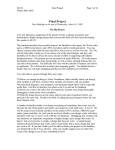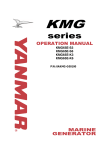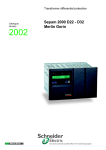Download Casablanca M8515-01 Datasheet
Transcript
AVR230: DES Bootloader Features • Fits All AVR Microcontrollers with Bootloader Capabilities • Enables Secure Transfer of Compiled Software or Sensitive Data to Any AVR with Bootloader Capabilities 8-bit Microcontroller • Includes Easy To Use, Configurable Example Applications • • • • • – Encrypting Binary Files and Data – Creating Target Bootloaders – Downloading Encrypted Files to Target Encryption Algorithm Follows Data Encryption Standard (DES) Triple Data Encryption Standard (3DES) for Increased Security DES Bootloader Fits Into 2-KB on All AVR Devices 3DES Bootloader Fits Into 2-KB on All AVR Devices, Except ATmega128 Typical Update Times of a 16-KB Application, Including Transfer of Data, Decryption and Programming of Flash Memory – DES, 115200 Bauds, 16 MHz Target Frequency: 20 Seconds – 3DES, 115200 Bauds, 16 MHz Target Frequency: 50 Seconds Application Note Introduction This application note describes how firmware can be updated securely on AVR microcontrollers with bootloader capabilities. The method includes using the Data Encryption Standard (DES) to encrypt the firmware. This application note also supports the Triple Data Encryption Standard (3DES). Electronic designs including a microcontroller always need to be equipped with a firmware, be it a portable music player, a hairdryer or a sewing machine. As many electronic designs evolve rapidly there is a growing need for being able to update products, which have already been shipped or sold. It may prove difficult to make changes to the hardware, especially if the product has already reached the end customer. But the firmware can easily be updated on products based on Flash microcontrollers, such as the AVR family. Many AVR microcontrollers are configured such that it is possible to create a bootloader able to receive firmware updates and to reprogram the Flash memory on demand. The program memory space is divided in two sections: the Bootloader Section (BLS) and the Application Section. Both sections have dedicated lock bits for read and write protection such that a bootloader code can be secured in the BLS while still being able to update the code in the application area. Hence, the update algorithm in the BLS can easily be secured against outside access. The problem remains with the firmware, which typically is not secured before it has been programmed into Flash memory and lock bits have been set. This means that if the firmware needs to be updated in the field, it will be open for unauthorized access from the moment it leaves the programming bench or manufacturer’s premises. Rev. 2541D–AVR–04/05 This application note shows how data to be transferred to Flash and EEPROM memories can be secured at all times by using cryptographic methods. The idea is to encrypt the data before it leaves the programming bench and decrypt it only after it has been downloaded into the target AVR. This procedure does not prevent unauthorized copying of the firmware, but the copy (and of course the original) is virtually useless without the proper decryption keys. Decryption keys are only stored in one location outside the programming environment: inside the target AVR. Provided that lock bits are set, the keys cannot be read from the target AVR. Also, the keys cannot be regenerated from the encrypted data. The only way to gain access to the data is by using the proper keys. Figure 1 shows an example of how a product is first manufactured, loaded with initial firmware, sold and later updated with a new revision of the firmware. Figure 1. An Example of the Production and Update Procedure of an AVR-based Design MANUFACTURER THIRD PARTY 3 FIRMWARE UPDATES FIRMWARE (INITIAL) 1 BOOTLOADER 4 FIRMWARE (UPDATE) DECRYPTION KEYS 2 PRODUCT SOLD PRODUCT BEING MANUFACTURED Notes: 2 PRODUCT BEING UPDATED 1. During manufacturing, the microcontroller is first equipped with bootloader, decryption keys and application firmware. The bootloader takes care of receiving the actual AVR230 App Note 2541D–AVR–04/05 AVR230 App Note application and programming it into Flash memory, while keys are required for decrypting the incoming data. Lock bits are set to secure the firmware inside the AVR. 2. The product is then shipped to a distributor or sold to the end customer. Lock bit settings continue to keep the firmware secured inside the AVR. 3. A new release of the firmware is completed and there is a need to update products, which already have been distributed. The firmware is therefore encrypted and shipped to the distributor. The encrypted firmware is useless without decryption keys and therefore even local copies of the software (for example, on the hard drive of the distributor) do not pose a security hazard. 4. The distributor upgrades all units in stock and those returned by customers (for example, during repairs). The encrypted firmware is downloaded to the AVR and decrypted only once inside the microcontroller. Lock bit settings continue to keep the updated firmware secured inside the AVR. Theory Cryptography is the art or science of keeping information secret and is based on either hiding the cryptographic method or securing the cryptographic key. Algorithms only based on the secrecy of the method used are mainly of historical interest and do not meet the needs of the real world. Modern algorithms use a key to control encryption and decryption. Without the matching key, the scrambled message or data cannot be arranged into plaintext. Encryption Encryption is the method of encoding a message or data such that its contents are hidden from outsiders. The plaintext message or data in its original form may contain information the author or distributor wants to keep secret, such as the firmware of a microcontroller. For example, when a microcontroller is updated in the field it may prove difficult to secure the firmware against illicit copying attempts and reverse engineering. Encrypting the firmware will render it useless until it is decrypted. Decryption Decryption is the method of retrieving the original message or data and typically cannot be performed without knowing the proper key. Keys can be stored in a bootloader of the microcontroller such that the device can receive encrypted data, decrypt it and reprogram selected parts of the Flash or EEPROM memory. Decryption keys cannot be retrieved from the encrypted data and cannot be read from AVR microcontrollers if lock bits have been programmed. Cryptographic Key Algorithms Algorithms based on cryptographic keys are divided in two classes; symmetric and asymmetric. Symmetric algorithms use the same key for encryption and decryption while asymmetric algorithms use different keys. The most studied and probably the most widely spread symmetric algorithm is DES. Data Encryption Standard – DES The Data Encryption Standard (DES) was originally developed in the 1970’s and was later turned into a standard by the US National Institute of Standards (NIST). DES is a symmetric cryptographic algorithm using a 56-bit key. The algorithm has proved very strong in practice and has outlived many others. 3 2541D–AVR–04/05 The DES algorithm uses a 56-bit encryption key, meaning that the number of possible key combinations is: 256 = 72,057,594,037,927,936 = 7.206 x 1016 DES is a block cipher, operating on blocks of 64 bits of data. Each input block is processed as illustrated in Figure 2. Figure 2. The Encryption Flow According to the DES Algorithm INPUT 64 INITIAL PERMUTATION 32 32 K1 L0 + + R0 48 32 32 f 32 L1 = R0 + K2 R1 + f L15 = R14 + K16 R15 + f R16 L16 = R15 INVERSE INITIAL PERMUTATION 64 OUTPUT Figure 2 illustrates how a single block of data is being encrypted. First, the order of the input bits is changed according to the permutation function. The low 32 bits (R0) are then processed separately from the high 32 bits (L0). There are 16 process steps, each step 4 AVR230 App Note 2541D–AVR–04/05 AVR230 App Note using a different subset (Kn) of the encryption key (only steps 1, 2 and 16 are illustrated in Figure 2). Finally, the bit order is changed inversely with respect to the initial permutation function. The decryption algorithm is the same as the encryption algorithm; only the sequence of the key subsets Kn is reversed. The DES algorithm is described in more details in the DES standard (see References section). Triple Data Encryption Standard – 3DES Triple Data Encryption Standard (3DES) is based on using DES three times, thus increasing the key length from 56 to 168 bits. 3DES is very much stronger than DES but rather slow for real-time applications, as compared to some newer algorithms. For this application note, timing is not critical and 3DES may be considered apt. The 3DES algorithm uses three 56-bit encryption keys. The number of possible key combinations therefore increases (wrt single DES) to: 2168 = 3.741 x 1050 3DES is based on using DES three times, as defined in ANSI x9.52. The encryption flow is illustrated below. Figure 3. The Encryption Flow According to the 3DES Algorithm INPUT DES ENCRYPTION KEY1 DES DECRYPTION KEY2 DES ENCRYPTION KEY3 OUTPUT During encryption, the input is first encrypted with the first key, then decrypted with the second key and finally encrypted with the third key. During decryption, the key sequence and encryption/decryption block sequence is reversed, as illustrated in Figure 4. 5 2541D–AVR–04/05 Figure 4. The Decryption Flow According to the 3DES Algorithm INPUT DES DECRYPTION KEY3 DES ENCRYPTION KEY2 DES DECRYPTION KEY1 OUTPUT The following keying options are defined in the standard. Table 1. 3DES Keying Options Option Number of Independent Keys Related Keys Keying Option 1 Three (KEY1, KEY2 and KEY3) (None) Keying Option 2 Two (KEY1 and KEY2) KEY3 = KEY1 Keying Option 3 One (KEY1) KEY1 = KEY2 = KEY3 It should be noted that only the first keying option (1) utilizes the full encryption length of 3DES. The third keying option (3) is essentially the same as single DES. Cipher Block Chaining – CBC DES and 3DES are block ciphers, meaning that the algorithm operates on fixed-size blocks of data. A 56-bit key is used to encrypt data in blocks of 64 bits. For a known input block and a constant (although, unknown) encryption key, the output block will always be the same. This information may provide useful for somebody wanting to attack the cipher system. There are some methods commonly used which cause identical plaintext blocks being encrypted to different ciphertext blocks. One such method is called Cipher Block Chaining (CBC). CBC is a method of connecting the cipher blocks such that leading blocks influence all trailing blocks. This is achieved by first performing an XOR operation on the plaintext block and the previous ciphertext block and then encrypting the result. This increases the number of plaintext bits one ciphertext bit depends on. How Safe Is It? It is important to understand that, in theory, it is possible to break any key-based cryptographic method simply by testing all possible keys in a sequence. Considering an ideal system that cannot be broken down otherwise, the level of data security is exponentially proportional to the length of the cryptographic key. A common method for illicit decryption attempts is using brute force, i.e. stepping through all possible keys and trying them one at a time until the output appears intelligible. No human operator can manually take on such a process, but it can be automated using specialized software or hardware. This yet requires that the human operator is able to model how to distinguish intelligible output from unintelligible. In brute force 6 AVR230 App Note 2541D–AVR–04/05 AVR230 App Note attacks, the computing power required to break the key increases exponentially with the length of the key. Since the average computing power increases exponentially over time, it is only a matter of time until any key can be broken. Table 2 illustrates the effect of key length versus encryption strength. It should be noted that these figures are guidelines only, and that there are large variations in many of the estimates. The information has been gathered from sources mentioned in the References section. Table 2. Time Estimates for Breaking Encryption Versus Length of Encryption Key (see References) Key Length Example Individuals, Small Companies Organized Criminals, Major Companies, Governments Standard PC Linked PCs 32 bits Minutes … Hours 40 bits Days … Weeks 56 bits DES 64 bits Virtually Unbreakable 80 bits 128 bits 168 bits 3DES Special Hardware Minutes … Hours Weeks … Months Hours … Days Very Long Short Long Virtually Unbreakable Virtually Unbreakable Another attack method is that of targeting the hardware, not the encrypted information. In this application note, the hardware is secured by Atmel’s Flash-based AVR microcontroller architecture. A DES/3DES bootloader including decryption keys is loaded into the Flash and the memory is then protected using lock bits. The firmware can now be updated in the field using encrypted patches but the decryption keys cannot be retrieved from the AVR. When lock bits are set, all write and external read access is denied. The only way to gain access to the memory is to erase the device. Doing so, bootloader and decryption keys will be destroyed before the lock bits are erased. Recommendations on How to Improve System Security This application note presents techniques that can be used when securing a design from outside access. Although no design can ever be fully secured it can be constructed such that the effort required to break the security is as high as possible. There is a significant difference between an unsecured design that a person with basic engineering skills can duplicate and a design that only few, highly skilled intruders can break. In the first example, the design is easily copied and even reverse engineered, violating the intellectual property of the manufacturer and jeopardizing the market potential for the design. In the second example, the effort required to break the design is so high that most intruders simply focus on developing their own products. There is only one general rule on how to build a secure system: it should be designed to be as difficult to break as possible. Any mechanism that can be used to circumvent security will be tried during a break attempt. Even exotic situations should be considered. A few examples of what must be considered are given below. What will happen if power is removed during a firmware update? What is the state of the microcontroller when power is restored back? Are lock bits and reset vectors set properly at all times? 7 2541D–AVR–04/05 Are there any assumptions that can be made on what cleartext data will look like? In order for DES to be broken by brute force methods, there must be a pattern to look for. The attacker cannot simply try all key combinations and watch the output, looking for intelligible firmware. The attack software will have to be configured to search for a known pattern, such as interrupt vectors at the start of program memory, memory areas padded with zero or one, and so on. Is there any feedback that can be derived from the decryption process? Any such feedback can help the attacker in constructing a brute force attack platform. For example, if the decryption algorithm inside the bootloader would give an OK/Not OK type of signal for each block processed then this signal could easily be routed as feedback to the attack platform. Should encrypted frames be sent in another order? If the first frame sent to the bootloader always includes the first block of the encrypted file then the attacker can make some assumptions from this. For example, it can be assumed the first frame maps program data starting from address zero and that it contains the interrupt vector table. This information helps the attacker to refine the key search. To increase the security of the system, send the frames in random order (the decrypted frames will be mapped to their proper address, anyhow). Implementation and Usage This section describes how to use and configure the applications. The process is illustrated in Figure 5. Figure 5. Overview of Project Flow Application Note Miscellaneous Editor Application Builder EEPROM Data Firmware Text Editor/GenTemp Configuration File Create Bootloader Source Header File IAR Embedded Workbench Bootloader Key File Encrypted Firmware Update Frames Target AVR The main steps are as follows: 1. Create an application for the target AVR. If required, create an EEPROM layout in a separate file. 2. Create a configuration file with project dependent information. The application called GenTemp can be used for creating a file frame. 3. Run the application called Create. This will create the header file, key file and the encrypted file. 4. Using IAR EW, configure and build the bootloader for the target AVR. 5. Download bootloader to target AVR and set lock bits & fuse bits. 6. Now the encrypted firmware may be downloaded to the AVR at any time. 8 AVR230 App Note 2541D–AVR–04/05 AVR230 App Note The procedure is discussed in more details below. Configuration File The configuration file contains a list of parameters, which are used to configure the project. The parameters are described in Table 3. Table 3. Summary of Configuration File Options Parameter Description Default Required PAGE_SIZE Size of AVR Flash page in decimal bytes. This figure is part-dependent. Please see datasheet. N/A Yes KEY1 First encryption key in hexadecimal. Should be eight random bytes, where every 8th bit is used as odd-parity bit None: No encryption No, but strongly recommended KEY2 Second encryption key. Similar to first key, but used in two-key 3DES. If omitted, single DES encryption will be used None: use single DES No, but recommended KEY3 Third encryption key. Similar to first key, but only used in three-key 3DES. If omitted, single or two-key DES encryption will be used None: use single or two-key DES No INITIAL_VECTOR Used for chaining cipher blocks. Should be eight random bytes in hexadecimal 0000000000000000 No, but strongly recommended SIGNATURE Frame validation data. This can be any four bytes, but it is recommended the values are chosen on random 00000000 Yes ENABLE_CRC Enable CRC checking: Yes or No. If enabled, all application section will be overwritten and the application must pass a CRC check before it is allowed to start No No, but recommended MEM_SIZE Size of application section in target AVR (in decimal bytes) None Yes, if CRC is used Note: The DES algorithm uses 56-bit keys, but the keys are given 8-byte (64 bits) wide in the configuration file. This is because every 8th bit is used as an odd-parity bit. The configuration file can be given any valid file name (the name is later given as a parameter to the application that will create the project files). Below is a sample configuration file for the ATmega16. PAGE_SIZE = 128 MEM_SIZE = 14336 KEY1 = 0123456789ABCDEF KEY2 = FEDCBA9876543210 KEY3 = 89ABCDEF01234567 INITIAL_VECTOR = 0011223344556677 SIGNATURE = 89ABCDEF ENABLE_CRC = YES Some of the parameters cannot be set without specific knowledge of the target AVR. Table 4 summarizes the features of some present AVR microcontrollers with bootloader functionality. For devices not present in this table, please refer to the datasheet of the device. 9 2541D–AVR–04/05 Table 4. AVR Feature Summary M8 M8515 Flash Size, bytes 8K Flash Page Size, bytes 64 M8535 M16 M32 M64 M128 32K 64K 128K 128 128 BLS (max), bytes 2048 256 256 512 4096 32 16 MEM_SIZE, bytes 6144 14336 PAGE_SIZE, bytes 64 PC Application – GenTemp M169 16K Flash Pages BLS Pages M162 8192 32 28672 128 57344 122880 256 This application note includes a small PC application, which will generate a template for the configuration file. The application generates random encryption keys and initial vectors, leaving other parameters for the user to be filled in (such as the Flash page size). It is recommended to always start with creating a template using this application, as this procedure guarantees truly random encryption keys and removes human predictability. The application is used as follows: GenTemp FileName.Ext … where FileName.Ext is the name of the configuration file, which will be created. After the file has been generated it can be edited using any plain text editor of choice. PC Application – Create This PC application has been created using Microsoft® Visual C++, version 6.0. It reads information from the configuration file and generates key and header files for the bootloader. It is also used for encrypting the firmware. Typically, the application is run at least twice; first, to generate key and header files for the bootloader and, second, when a new firmware is encrypted. Note: It is very important that the same encryption information (configuration file) is used when generating project files and when encoding the firmware. Otherwise, the bootloader may not have the correct set of encryption keys and cannot decrypt the data. It should also be noted that it is possible to use the information in the configuration file to decrypt the encrypted firmware. Hence, the configuration file must be kept safe at all times and should not be modified after it has been used for the first time. 10 AVR230 App Note 2541D–AVR–04/05 AVR230 App Note Command Line Arguments The application accepts the following command line arguments. Table 5. Summary of Command Line Arguments First Run Argument Description -c <filename.ext> Path to configuration file -d If set, contents of each Flash page is deleted before writing. Else, previous data will be preserved if not specifically written to. -e <filename.ext> Path to EEPROM file (data that goes into EEPROM) -f <filename.ext> Path to Flash file (code that goes into Application Section) -h <filename.ext> Name of output header file. This file must later be included with the bootloader. -k <filename.ext> Name of output key file. This file must later be included with the bootloader. -l [BLB12] [BLB11] [BLB02] [BLB01] Lock bits to set. These lock bits are set after all data has been transferred and before control is transferred to the updated application. -n Nonsense. Add random number of nonsense records to encrypted file. As nonsense records are ignored by the bootloader, this setting does not affect the application, only the predictability of the output file. -o <filename.ext> Output file name. This is the encrypted file that may be distributed and sent to the target when it needs to be updated. In the first run, typically, only key and header files for the bootloader are generated. The generation of key and header files is requested using command line arguments. For example: Create –c Config.txt –h BootLdr.h –k DESKeys.inc The key and header files must be copied to the project directory of the bootloader application and be included into the bootloader code. Note: Subsequent Runs Please note that the bootloader project files are preconfigured to use the file names mentioned above, i.e. BootLdr.h and DESKeys.inc. It is recommended these file names are not changed. In subsequent runs, the application is used for encoding the firmware. Prior to encryption, the source file must be compiled, assembled and linked into one code segment file and/or one EEPROM segment file. Files must be of type Intel hex. A file name is given at the command prompt and an encrypted file will be generated according to data in the configuration file. For example: Create –c Config.txt –e EEPROM.hex –f Flash.hex –o Update.enc –l BLB11 BLB12 The application software and EEPROM data files will be combined into a single encrypted file. Program Flow The program flow is illustrated in Figure 6. 11 2541D–AVR–04/05 Figure 6. Program Flow of PC Application Create NONE OTHER Command Line Args? Give Instructions Read Configuration File Done How Many Keys? ONE DES Keying Option 3: 56 bits (all three keys are equal) NO THREE TWO Key File Name Given? DES Keying Option 2: 112 bits (keys 1 and 3 are equal) DES Keying Option 1: 168 bits (all three keys are independent) YES Create Key File NO Header File Name Given? YES Create Header File YES Flash File Name Given? NO Include Flash File In Encryption YES EEPROM File Name Given? NO Include EEPROM File In Encryption NO Output File Name Given? YES Create Encrypted File Done 12 AVR230 App Note 2541D–AVR–04/05 AVR230 App Note The Encrypted File The Flash and EEPROM file are encrypted and stored in one target file. Before encryption, however, data is organiszed into records. There are seven types of records, as illustrated in Figure 7. Figure 7. Types of Records RECORD TYPE LAYOUT END OF FRAME 0 FLASH PAGE ERASE 1 AB NB FLASH PAGE PREPARE 2 AB NB FLASH PAGE DATA 3 AB NB FLASH PAGE PROGRAM 4 AB NB EEPROM SECTION DATA 5 AB NB LOCK BITS 6 L RESET 7 NONSENSE N LEGEND (VARIABLE LENGTH) AB ADDRESS IN BYTES NB LENGTH IN BYTES L LOCK BITS R RANDOM DATA N ANY VALUE IN 8...255 (VARIABLE LENGTH) R R The record type is given as the first byte in the record. The application data is broken down to record types 1, 2, 3 and 4 (i.e., erase, prepare, load and write buffer page to Flash). The data for the EEPROM section is formatted into record type 5. Lock bits are sent in record type 6. Record types 0 and 7 are for ending a frame and transmission, respectively. All other records, i.e. those with a record identifier above 7, are of type nonsense. When this option is enabled (see Create tool), a random number of nonsense records will be placed at random locations in the file. The output file is created as illustrated in the Figure 8. 13 2541D–AVR–04/05 Figure 8. Creating the Encrypted File STEP 1 STEP 2 SIG INITIAL VECTOR RECORD CIPHER BLOCK CIPHER BLOCK RECORD RECORD CIPHER BLOCK RECORD CIPHER BLOCK Z F CIPHER BLOCK STEP 3 CHAINED AND ENCRYPTED DATA STEP 4 CHAINED AND ENCRYPTED DATA C CHAINED AND ENCRYPTED DATA C STEP 5 L FILE FRAME The steps are described below (numbers refer to Figure 8). 1. Data is formatted into records, which are then lined up following the frame signature (SIG). A zero (Z) is added to mark the end of the frame and the frame is padded with random data (F) to create an even 64-bit product. 2. The initial vector is attached to the frame. In the first frame, the vector is equal to the one given in the configuration file. In subsequent frames, the initial vector is equal to the last cipher block of the previous frame. 3. The initial vector and cipher blocks are chained and encrypted. The initial vector is then removed from the frame. 4. A CRC-16 checksum (C) is calculated and added to the frame. 5. The length (L) of the frame, excluding the length information, is calculated and saved at the start of the frame. The frame is written to the output file and the procedure is repeated until all data has been processed. Bootloader 14 The bootloader must reside in the target AVR before the device can be updated with encrypted firmware. The bootloader communicates with the PC and is capable of programming the EEPROM and the application area of the Flash memory. The bootloader included with this application note has been created using IAR Embedded Workbench, version 2.28a, but it can be ported to any other C compiler. The program flow is illustrated in Figure 9. AVR230 App Note 2541D–AVR–04/05 AVR230 App Note Figure 9. Program Flow of AVR Bootloader Bootldr NO YES Switch SW7 Pressed? Load Initial Vector for CBC NO CRC Check Enabled? Read Frame Size (Two Characters) YES Calculate CRC of Appl. Section NO Read Character, Store in RAM Application CRC Valid? Update Frame CRC Counter YES NO End of Frame? Jump to Application YES YES Frame CRC Valid? Decrypt and Unchain YES ERASE NO Send Frame CRC Error NO Signature Valid? NOTE WELL: IF CRC IS VALID, FRAME IS DECRYPTED. ANY INFORMATION SENT ON DECRYPTION STATUS OTHER THAN OK MAY BE USED IN AN ATTACK ATTEMPT Ignore Frame BUT Send OK Type? Erase Page PREPARE Prepare Page DATA Load Data PROGRAM Write Page EEPROM Write EEPROM LOCKBITS Write Lock Bits NONSENSE Do Nothing RESET EOF Set Initial Vector Send OK 15 2541D–AVR–04/05 Key and Header Files Before the bootloader can be compiled, there are some parameters that need to be set up. To start with, the encryption key and target header files generated by the PC application Create must be copied to the directory of the bootloader so that they may be included in the bootloader. The files will be included when they are referred to with the #include directive inside the bootloader source code. For example (this is a copy of the beginning of the des.c source code): ... #include "des.h" #include "bootldr.h" #include "loader.h" #if KEY_COUNT > 0 #include "deskeys.inc" ... Project Files This application note comes with device specific project files for the following devices: • ATmega8 • ATmega8515 • ATmega16 • ATmega169 • ATmega32 • ATmega64 • ATmega128 Use the predefined project files with the corresponding AVR. For AVR devices not listed, use the project file for a device that matches the target device as close as possible and modify the following sections, as described below. Linker File The IAR compiler requires a modified linker file because the bootloader will reside in the upper memory area, i.e. in the Bootloader Section (BLS). Linker files have an extension of .xcl and are distributed with the IAR compiler for each AVR device separately. This application note comes with two linker files, one of which should be used (depending on the set-up of the choice of interrupt vector table). Table 6. Linker File Selection Linker File Name Use With bootldr.xcl All AVR devices, interrupt vector table allocated for code (saves memory) bootldr_interrupts.xcl All AVR devices, interrupt vector table padded with RETI The linker file is defined under “Project” – “Options”, category “XLINK”, tab “Include”, field “XCL file name”. Note that the linker file is already set up in the device specific project files that come with this application note. Other Compiler Settings In the Project window, set Targets to Release. This will create no debug code and minimize overall code size of the bootloader. Code size is critical for AVR devices with only 2-KB Boot Section. Note: If Target is not set to Release, the project will not necessarily link properly. The following settings need to be defined in the dialog window found under “Project” – “Options”. Note that all settings are already defined in the device specific project files. 16 AVR230 App Note 2541D–AVR–04/05 AVR230 App Note Table 7. Required Compiler Settings Category Tab Set to Example General Target Set “Processor configuration” to match target AVR -cpu=m8, AT90mega8 Set “Memory model” to Small Uncheck “Configure system using dialogs (not in .XCL file)” AAVR XLINK Library Configuration Check “Enable bit definitions in I/O-include files” Preprocessor Define symbol “INCLUDE_FILE” to match target AVR INCLUDE_FILE=”iom8.h” Define symbol SPMREG to match target SPMREG=SPMCR Output Define output file format such that the file can programmed to the target. Set to Intel-standard #define Define symbol BOOT_SIZE to match target bootloader section. In hex bytes BOOT_SIZE=800 Define symbol FLASH_SIZE to match Flash size of target. In hex bytes FLASH_SIZE=2000 Define symbol IVT_SIZE to match size of target interrupt vector table. In hex bytes IVT_SIZE=26 Define symbol RAM_SIZE to match amount of RAM on target. In hex bytes RAM_SIZE=400 Define symbol RAM_BASE to match start of SRAM (following I/O area). In hex bytes RAM_BASE=60 Include Under section “XCL file name”, check “Override default” Under section “XCL file name”, enter file name in box $PROJ_DIR$\bootldr.xcl The following table summarizes some of the compiler options for currently supported AVR devices. Please note that bootloader start address depends on fuse settings, as explained later (see Tables 8 and 9. Recommended Fuse Bits). Table 8. Compiler Setting Reference (wrt Recommended Fuse Settings) M8 M8515 M16 M169 Linker File Name M128 800 1000 8000 10000 20000 58 8C 8C 800 1000 1000 60 100 100 800 FLASH_SIZE Installing the Bootloader M64 bootldr.xcl BOOT_SIZE 2000 4000 IVT_SIZE 26 22 RAM_SIZE 400 200 RAM_BASE M32 60 54 5C 400 100 Compile the bootloader and then download it to the target using AVR Studio®. Before running the bootloader, the following fuse bits must be configured: • Size of Bootloader Section. Set fuse buts such, that the section size matches the BOOT_SIZE setting, as described earlier. Note that the BLS is usually given in words, but the BOOT_SIZE parameter is given in bytes. • Boot reset vector. The boot reset vector must be enabled. 17 2541D–AVR–04/05 • Oscillator options. The oscillator fuse bits are device dependent. They may require configuration (affects USART). Note: Please pay special attention in setting oscillator options correctly. Even small misadjustments will probably result in communication failure. The software is designed for using an 8 MHz oscillator frequency. TTable 9 lists the recommended fuse bit settings. See datasheet for detailed explanation of device dependent fuse bits. Table 9. Recommended Fuse Bits (“0” Means Programmed, “1” Means Not Programmed) M8 M8515 M16 M169 M32 M64 M128 BOOTSZ1 0 0 BOOTSZ0 0 1 BOOTRST 0 0 It is recommended to program lock bits to protect memory and bootloader, but only after fuse bits have been set. Lock bits can be programmed using AVR Studio. BLS lock bits will also be set during firmware update, provided that they have been defined as command line arguments when the firmware is encrypted. The recommended lock bit settings are: • Memory lock bits: these should be set to prevent unauthorized access to memory. Note: after the memory has been locked it cannot be accessed via in-system programming without erasing the device • Protection mode for Bootloader Section: SPM and LPM should not be allowed to write to or read from the BLS. This will prevent the firmware in the application section to corrupt the bootloader and will keep the decryption keys safe • Protection mode for application section: no restrictions should be set for SPM or LPM accessing the application section, otherwise the bootloader cannot program it Note: It is important to understand that if the device is not properly locked then memory can be accessed via an ISP interface and the whole point of encrypting the firmware is gone. The following table lists the recommended lock bit setting for present AVR microcontrollers. See datasheet for detailed explanation of lock bits. Table 10. Recommended Lock Bit Settings M8 PC Application – Update 18 M8515 M16 M169 BLB12 : BLB11 00 BLB02 : BLB01 11 M32 M128 The update application has been created using Microsoft Visual C++, version 6.0. It is used for sending the encrypted file (including EEPROM, Flash and Lock Bit information) to the target. The data can be sent via a serial port on the PC directly to the USART on the target hardware. The program flow is illustrated in Figure 10. AVR230 App Note 2541D–AVR–04/05 AVR230 App Note Figure 10. Program Flow of Update Application Update Two Arguments? NO YES NO YES Port Number Given? NO YES File Exists? Show Error Message NO YES Port Initialises? Show Error Message Read All File Into Buffer Give Instructions Close File Initialise Buffer Pointer Done Read Size of Next Frame CRC OK Byte Value? Flush Input of Serial Port Reset Retry Counter NO Send Frame Retry < 4? YES Increase Pointer Byte Received? YES Show CRC Error Message Increase Retry Counter NO Show Error Message NO Pointer < Size of Buffer? YES Close Serial Port Close File Done The Update application reads in files generated with the Create application. The file consists of one or more concatenated frames of encrypted data. The application transmits data one frame at a time, pausing in between to wait for a reply from the bootloader. The next frame is transmitted only after an acknowledgement has been received, otherwise the application will either resend the frame or close communication. 19 2541D–AVR–04/05 The update application is run from the command prompt. The command prompt arguments are listed in Table 11. Table 11. Command Prompt Arguments for Update Application Argument Description <filename.ext> Path to encrypted file, which is going to be transferred -COMn Serial port, where n is the serial port number It should be noted that the update system only updates those parts of the Flash and EEPROM denoted in the application and EEPROM files. If CRC check of application section is enabled, or the erase option is selected in the Create tool, all application memory will be cleared before programming. Hardware Set-Up The target hardware must be properly set up before the encrypted firmware can be sent to the bootloader. In this application note, it is assumed an STK500 is used as the target. The STK500 should be configured as follows: 1. Connect the STK500 (via connector labeled “RS232 CTRL”) to the PC using a serial cable. Power on the STK500 2. Use AVR Studio to download the bootloader and set fuse and lock bits, as described earlier. Power off the STK500 3. Move the serial cable to the connector labeled “RS232 SPARE” 4. Connect the RXD/TXD lines of the device to pin RXD and TXD of the connector labeled RS232 SPARE. PD0 should go to RXD and PD1 to TXD 5. Connect PD8 (pin 8 of PORTD) to SW7 (pin 8 of SWITCHES) 6. Press and hold down SW7 while switching on the STK500. This will start the bootloader and set it in update mode 7. Release switch SW7 8. The Update application on the PC can now be used to send encrypted data to the target Performance The following sections summarize system performance with respect to execution time and code size. Speed The time required for the target device to receive, decode and program data depends on the following factors: 20 • File size. The more data that needs to be transferred, the longer the time it takes • Baudrate. The higher the transmission speed, the shorter the transmission time • Target AVR speed. The higher the clock frequency, the shorter the decoding time • Programming time of Flash page. This is a device constant and cannot be altered • Number of keys. Single-key DES is faster to decrypt than three-key 3DES • Miscellaneous settings. For example, CRC check of application section takes a short while AVR230 App Note 2541D–AVR–04/05 AVR230 App Note For single-key DES, the overall time can be estimated using the following equation. 5 1 T DES ≈ FS × ⎛ ------- + --------------⎞ + 3 ⎝ BR 60 × f⎠ …where FS is the filesize in bytes, BR is the baudrate (transmission speed) and f is the clock frequency in MHz. Please note that this only gives an estimation and that, for example, the ATmega128 differs slightly (replace constant 60 by 54). The default setting is a transmission speed of 9600 bauds and a clock frequency of 8 MHz. This simplifies the equation, as follows. T DES ≈ 0, 0026 × FS + 3 For 3DES, the overall time can be estimated using the following equation. 5- + ------------1 -⎞ + 3 T 3DES ≈ FS × ⎛ -----⎝ BR 22 × f⎠ At default settings, the equation can be simplified, as follows. T 3DES ≈ 0, 0062 × FS + 3 The DES decryption itself takes 245k cycles per block for DES and 724k cycles per block for 3DES. This gives a throughput of 32 bytes/s/MHz for DES and 10 bytes/s/MHz for 3DES. Size The following table summarizes the code size of the bootloader with respect to target device and compilation options. It may be noted that all bootloader options fit into 2-KB, except for 3DES bootloader running on ATmega128. Table 12. Size of Bootloader in Bytes CRC Not Enabled CRC of Application Section Enabled No DES DES, 56-bit DES, 56-bit 3DES, 112-bit 3DES, 168-bit ATmega8 436 1684 1716 1818 1914 ATmega8515 436 1684 1716 1818 1914 ATmega16 476 1752 1786 1888 1984 ATmega169 500 1776 1810 1910 2008 ATmega32 476 1752 1786 1888 1984 ATmega64 504 1810 1844 1946 2042 ATmega128 588 1897 1945 2049 2143 It should be noted that if no encryption keys are given, the bootloader is built without DES/3DES support. This application note then performs as a standard bootloader system and can be used on any AVR with bootloader support. 21 2541D–AVR–04/05 Summary This application note has presented a method for transferring data securely to an AVR microcontroller with bootloader capabilities. This document has also highlighted techniques, which should be implemented when building a secured system. As a summary, the following issues should be considered in order to increase the security of an AVR design. • Implement a bootloader that supports downloading in encrypted form. When the bootloader is first installed (during manufacturing) it must be equipped with decryption keys, required for future firmware updates. The firmware can then be updated encrypted, securing the contents from outsiders. • Use AVR lock bits to secure Application and Bootloader Sections. When lock bits are set to prevent read from the device, the memory contents cannot be retrieved. If lock bits are not set, there is no use encrypting the firmware. • Encrypt the firmware before distribution. Encrypted software is worthless to any outside entity without the proper decryption keys. • Keep encryption keys safe. Encryption keys should be stored in two places only: in the bootloader, which has been secured by lock bits and in the firmware development bench at the manufacturer. • Chain encrypted data. When data is chained, each encrypted block depends on the previous block. As a consequence, equal cleartext blocks produce different encrypted outputs. • Avoid standard, predictable patterns in the firmware. Most programs have a common framework and any predictable patterns, such as an interrupt vector table starting with a jump to a low address, only serve to help the intruder. Also avoid padding unused memory areas with a constant number. • Hide the method. There is no need to mention which algorithm is being used or what the key length is. The less the intruder knows about the system, the better. It may be argued that knowing the encryption method fends off some attackers, but knowing nothing about the method increases the effort and may fend off even more. • The bootloader may also be used to erase the application section, if required. Many attack attempts include removing the device from its normal working environment and powering it up in a hacking bench. Detecting, for example, that an LCD is missing or that there are CRC errors in memory, the bootloader may initiate a complete erase of all memory (including the bootloader section and decryption keys). • In applications where it is not feasible or possible to use an external communications channel for updates, the firmware can be stored in one of Atmel’s CryptoMemory® devices. The memory can be packaged as a removable smart card, which can easily be inserted in a slot of the device when upgrade is needed. The microcontroller can check for the presence of a CryptoMemory upon boot and retrieve a firmware upgrade as needed. • Use only secure hardware. A strong encryption protocol is useless if the hardware has structural flaws. There are no reported security issues with AVR microcontrollers. This list can be made very long but the purpose of it is merely to set the designer off in the right direction. Do not underestimate the wit or endurance of your opponent. 22 AVR230 App Note 2541D–AVR–04/05 AVR230 App Note References [1] Douglas Stinson: Cryptography: Theory and Practice, CRC Press, second edition, 1996 [2] Electronic Frontier Foundation: Cracking DES, 1998: http://www.eff.org/descracker.html [3] Electronic Privacy Information Center: http://www.privacy.org [4] International Association for Cryptologic Research: http://www.swcp.com/~iacr [5]Man Young Rhee: Cryptography and Secure Data Communications, McGraw-Hill, 1994 [6] SSH Communications Security http://www.ssh.com 23 2541D–AVR–04/05 Atmel Corporation 2325 Orchard Parkway San Jose, CA 95131, USA Tel: 1(408) 441-0311 Fax: 1(408) 487-2600 Regional Headquarters Europe Atmel Sarl Route des Arsenaux 41 Case Postale 80 CH-1705 Fribourg Switzerland Tel: (41) 26-426-5555 Fax: (41) 26-426-5500 Asia Room 1219 Chinachem Golden Plaza 77 Mody Road Tsimshatsui East Kowloon Hong Kong Tel: (852) 2721-9778 Fax: (852) 2722-1369 Japan 9F, Tonetsu Shinkawa Bldg. 1-24-8 Shinkawa Chuo-ku, Tokyo 104-0033 Japan Tel: (81) 3-3523-3551 Fax: (81) 3-3523-7581 Atmel Operations Memory 2325 Orchard Parkway San Jose, CA 95131, USA Tel: 1(408) 441-0311 Fax: 1(408) 436-4314 RF/Automotive Theresienstrasse 2 Postfach 3535 74025 Heilbronn, Germany Tel: (49) 71-31-67-0 Fax: (49) 71-31-67-2340 Microcontrollers 2325 Orchard Parkway San Jose, CA 95131, USA Tel: 1(408) 441-0311 Fax: 1(408) 436-4314 La Chantrerie BP 70602 44306 Nantes Cedex 3, France Tel: (33) 2-40-18-18-18 Fax: (33) 2-40-18-19-60 ASIC/ASSP/Smart Cards 1150 East Cheyenne Mtn. Blvd. Colorado Springs, CO 80906, USA Tel: 1(719) 576-3300 Fax: 1(719) 540-1759 Biometrics/Imaging/Hi-Rel MPU/ High Speed Converters/RF Datacom Avenue de Rochepleine BP 123 38521 Saint-Egreve Cedex, France Tel: (33) 4-76-58-30-00 Fax: (33) 4-76-58-34-80 Zone Industrielle 13106 Rousset Cedex, France Tel: (33) 4-42-53-60-00 Fax: (33) 4-42-53-60-01 1150 East Cheyenne Mtn. Blvd. Colorado Springs, CO 80906, USA Tel: 1(719) 576-3300 Fax: 1(719) 540-1759 Scottish Enterprise Technology Park Maxwell Building East Kilbride G75 0QR, Scotland Tel: (44) 1355-803-000 Fax: (44) 1355-242-743 Literature Requests www.atmel.com/literature Disclaimer: The information in this document is provided in connection with Atmel products. No license, express or implied, by estoppel or otherwise, to any intellectual property right is granted by this document or in connection with the sale of Atmel products. EXCEPT AS SET FORTH IN ATMEL’S TERMS AND CONDITIONS OF SALE LOCATED ON ATMEL’S WEB SITE, ATMEL ASSUMES NO LIABILITY WHATSOEVER AND DISCLAIMS ANY EXPRESS, IMPLIED OR STATUTORY WARRANTY RELATING TO ITS PRODUCTS INCLUDING, BUT NOT LIMITED TO, THE IMPLIED WARRANTY OF MERCHANTABILITY, FITNESS FOR A PARTICULAR PURPOSE, OR NON-INFRINGEMENT. IN NO EVENT SHALL ATMEL BE LIABLE FOR ANY DIRECT, INDIRECT, CONSEQUENTIAL, PUNITIVE, SPECIAL OR INCIDENTAL DAMAGES (INCLUDING, WITHOUT LIMITATION, DAMAGES FOR LOSS OF PROFITS, BUSINESS INTERRUPTION, OR LOSS OF INFORMATION) ARISING OUT OF THE USE OR INABILITY TO USE THIS DOCUMENT, EVEN IF ATMEL HAS BEEN ADVISED OF THE POSSIBILITY OF SUCH DAMAGES. Atmel makes no representations or warranties with respect to the accuracy or completeness of the contents of this document and reserves the right to make changes to specifications and product descriptions at any time without notice. Atmel does not make any commitment to update the information contained herein. Atmel’s products are not intended, authorized, or warranted for use as components in applications intended to support or sustain life. © Atmel Corporation 2005. All rights reserved. Atmel ®, logo and combinations thereof, AVR ®, and AVR Studio ® are registered trademarks, and Everywhere You Are ™ are the trademarks of Atmel Corporation or its subsidiaries. Other terms and product names may be trademarks of others. Printed on recycled paper. 2541D–AVR–04/05

































